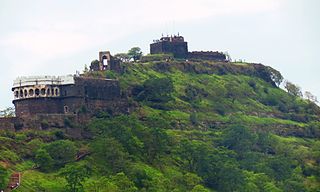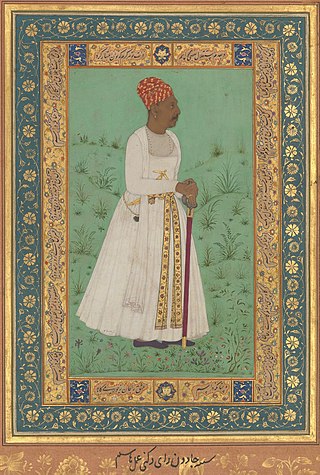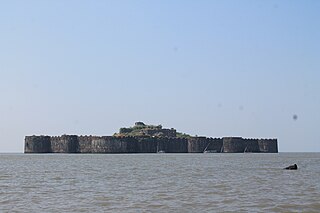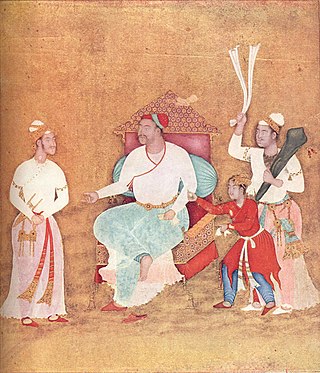
The Deccan sultanates is a historiographical term referring to five late medieval to early modern Indian kingdoms on the Deccan Plateau between the Krishna River and the Vindhya Range that were created from the disintegration of the Bahmani Sultanate and ruled by Muslim dynasties: namely Ahmadnagar, Berar, Bidar, Bijapur, and Golconda. The five sultanates owed their existence to the declaration of independence of Ahmadnagar in 1490, which was followed by Bijapur and Berar in the same year. Bidar became independent in c. 1492, and Golconda in 1512.

Daulatabad Fort, originally Deogiri Fort, is a historic fortified citadel located in Daulatabad village near Chhatrapati Sambhaji Nagar, Maharashtra, India. It was the capital of the Yadavas, for a brief time the capital of the Delhi Sultanate (1327–1334), and later a secondary capital of the Ahmadnagar Sultanate (1499–1636).

The Salar Jung Museum is an art museum located at Dar-ul-Shifa, on the southern bank of the Musi River in the city of Hyderabad, Telangana, India. It is one of the notable National Museums of India. Originally a private art collection of the Salar Jung family, it was endowed to the nation after the death of Salar Jung III. It was inaugurated on 16 December 1951.

The Sultanate of Bijapur was an early modern kingdom in the western Deccan and South India, ruled by the Adil Shahi dynasty. Bijapur had been a taraf (province) of the Bahmani Kingdom prior to its independence in 1490 and before the kingdom's political decline in the last quarter of the 15th century. It was one of the Deccan sultanates, the collective name of the kingdom's five successor states. The Sultanate of Bijapur was one of the most powerful states on the Indian Subcontinent at its peak, second to the Mughal Empire which conquered it in 1686 under Aurangzeb.

The Battle of Talikota, also known as that of Rakkasagi–Tangadagi, was a watershed battle fought between the Vijayanagara Empire and an alliance of the Deccan sultanates. The battle resulted in the defeat and death of Rama Raya, the de facto ruler of the Vijayanagara Empire, which led to the immediate collapse of the Vijayanagara polity and reconfigured South Indian and Deccan politics.

Malik Ambar was a military leader and statesman who served as the Peshwa of the Ahmadnagar Sultanate and its de facto ruler from 1600 until his death in 1626.
The Berar sultanate was an early modern Indian kingdom in the Deccan, ruled by the Imad Shahi dynasty. It was one of the Deccan sultanates, and was established in 1490 following the disintegration of the Bahmani Sultanate by Fathullah Imad-ul-Mulk. It was annexed by the Ahmadnagar Sultanate in 1574 following an invasion.

The Sultanate of Ahmednagar was a late medieval Indian Marathi kingdom located in the northwestern Deccan, between the sultanates of Gujarat and Bijapur, ruled by the Nizam Shahi dynasty. It was established when Malik Ahmed, the Bahmani governor of Junnar, after defeating the Bahmani army led by general Jhangir Khan on 28 May 1490, declared independence and established the Ahmadnagar Sultanate.

Lakhuji Jadhav Rao, also known as Lakhuji Jadhav was a Maratha statesman and Mansabdar who initially served the Ahmadnagar Sultanate and later joined the Mughals. He was a prominent figure in the politics of Deccan. Lakhuji was a well-known member of Jadhav Rao clan descendants of the Yadavas of Devagiri. He was also a Jagirdar of Sindkhed Raja. He was father of Jijabai, and grandfather of Shivaji, who was founder of the Maratha Empire.
Hyderabad is the capital of the Indian state of Telangana. It is a historic city noted for its many monuments, temples, mosques and bazaars. A multitude of influences have shaped the character of the city in the last 400 years.

The Deccan sultanates were five early modern kingdoms, namely Bijapur, Golkonda, Ahmadnagar, Bidar, and Berar, which ruled the Deccan Plateau for part of the 15th, and the majority of the 16th–17th centuries. Their architecture was a regional variant of Indo-Islamic architecture, and influenced by the styles of the Delhi Sultanate and later Mughal architecture, but sometimes also influenced from Persia and Central Asia. Hindu temple architecture in the same areas had very different styles.

Hussain Nizam Shah I was the preeminent ruler of the Ahmadnagar Sultanate and the leading figure of the coalition of the Deccan Sultanates during the Battle of Talikota. Notably, Hussain Nizam Shah was responsible for taking prisoner and beheading Rama Raya of Vijayanagara after the Battle of Talikota.

The Deccanis or Deccani people are an Indo-Aryan ethno-religious community of Deccani-speaking Muslims who inhabit or are from the Deccan region of India. The community traces its origins to the shifting of the Delhi Sultanate's capital from Delhi to Daulatabad in 1327 during the reign of Muhammad bin Tughluq. Further ancestry can also be traced from immigrant Muslims referred to as Afaqis, also known as Pardesis who came from Central Asia, Iraq and Iran and had settled in the Deccan region during the Bahmani Sultanate (1347). The migration of Muslim Hindavi-speaking people to the Deccan and intermarriage with the local Hindus who converted to Islam, led to the creation of a new community of Hindustani-speaking Muslims, known as the Deccani, who would come to play an important role in the politics of the Deccan. Their language, Deccani, emerged as a language of linguistic prestige and culture during the Bahmani Sultanate, further evolving in the Deccan Sultanates.

Deccan painting or Deccani painting is the form of Indian miniature painting produced in the Deccan region of Central India, in the various Muslim capitals of the Deccan sultanates that emerged from the break-up of the Bahmani Sultanate by 1520. These were Bijapur, Golkonda, Ahmadnagar, Bidar, and Berar. The main period was between the late 16th century and the mid-17th, with something of a revival in the mid-18th century, by then centred on Hyderabad.
Pushkar Sohoni is an architect, and an architectural and cultural historian. He is an associate professor in the department of Humanities and Social Sciences at the Indian Institute of Science Education and Research, Pune. He was Chair of the department from 2019 to 2024.
Sabaji Koli was the commander-in-chief of the army of Ahmednagar Sultanate. Sultan Burhan Nizam Shah of Ahmednagar conferred the title of Parvat Rai on Sabaji Koli. After the Sultan's death, Koli fought against the Vijayanagara Empire during the reign of the new Sultan Husain Nizam Shah. Burhan Nizam Shah also used to call Sabaji Koli Prataparaja, Parashurampratap and Narasimha Pratap.

The Architecture of a Deccan Sultanate: Courtly Practice and Royal Authority in Late Medieval India is a book by the architectural and art historian Pushkar Sohoni, published in 2018 by I.B. Tauris. It is one of the most comprehensive works on the architecture and urban settlements of the Nizam Shahs of Ahmadnagar, who ruled in the sixteenth century.

Damri Masjid, sometimes spelt Damdi Masjid, is a mosque in Ahmednagar, in the Indian state of Maharashtra. It was built during the reign of the Ahmednagar Sultanate in 1568. It is designated as a monument of national importance.

Golconda painting refers to the school of miniature painting developed during the reign of the Golconda Sultanate. It is itself a type of Deccan painting, and closely related to other Deccan schools, such as Bijapur and Ahmednagar.

Pem Nem is a 16th-century manuscript commissioned at the court of the Bijapur Sultanate. It belongs to the Prem Marg genre of Sufi literature, where a love story forms a metaphor representing the quest for the union with God. Written in an early form of Dakhni, it is a mathnawi, a long narrative poem written in rhyming couplets.


















